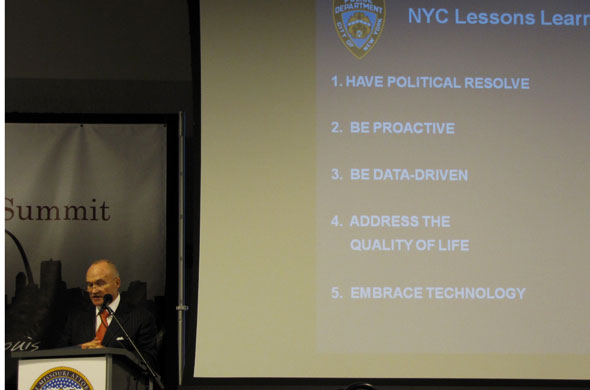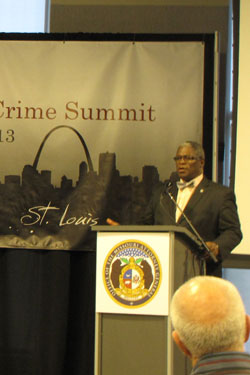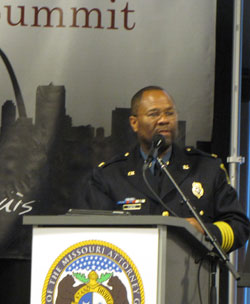
New York City Police Commissioner Raymond Kelly shared lessons New York has learned in reducing its murder rate.
Kansas City and St. Louis are among the top 10 cities in homicide rates, and officials want that to change.
A four-day urban crime summit started Monday at UMKC to probe for ways to reduce violent crime in the two cities.
Chris Koster, Missouri attorney general, put together the effort that goes for two days here and two days in St. Louis.
Other participants on the panel are the mayors and police chiefs of both cities.
Koster started with proof the problem is not hopeless: since 1990, New York City has reduced its homicide rate of 14 per 100,000 population to 4 per 100,000.
Compare that to 22 per 100,000 last year in Kansas City and 35 per 100,000 in St, Louis.
“This senseless violence can be stopped,” Koster said. After the four days of presentations by experts and discussion, his office in December will make recommendations for changes, he said.
Among the first speakers Monday was New York City Police Commissioner Raymond Kelly.
Violent crime has dropped dramatically there and continues to drop, he said, with homicides going from 2,245 in 1990 to 419 last year.
He credited many things:
Hot spot policing called “operation impact” sends police resources to high crime areas.
After they found that about 30 percent of shootings were by teens operating as neighborhood gangs, they doubled the gang squad and started monitoring social media, where the young shooters could not resist bragging.
They provide many programs and mentors to work with youth and also work with clergy and others on the problem.
Police there are “data driven.”
“Where does it occur, when does it happen – we want every commander to know those numbers cold,” Kelly said.
They have a massive crime intelligence database that all police can quickly access, and they make use of about 5,000 cameras on the streets.
“Don’t be camera shy, we say.”
They target domestic violence and use a police inspection unit to monitor how police are handling it. Domestic violence homicides declined 28 percent last year and are down 25 percent more this year.
They use “clean sweep” operations to attack crimes like graffiti, prostitution and public drunkenness that degrade neighborhoods.
Their police ranks reflect the population, with a majority of them now made up of minorities.
He defended the stop-and-frisk policy that a federal judge ruled unconstitutional in August. The city is appealing that and does not agree, Kelly said.
Who to stop cannot be based on census data, he said, or police would have to do it to far more women, “which makes no sense.”
He said 97 percent of all shooting victims there last year were black or Hispanic and lived in poor areas, where people are more likely to get stopped.
He also noted that New York state and city now have probably the toughest gun laws in the United States.
Even rifles have to be registered and people can’t own a handgun without a permit. Those are for target shooting, security guard work or a full-carry permit, but very few full-carry permits are granted.
But those laws are of limited value because the majority of guns there come from other states in what is called “the iron pipeline,” Kelly said.
 Mayor Sly James, in his opening, said 49 percent of the homicides in Kansas City happen in a 13-square-mile area east of Troost Avenue.
Mayor Sly James, in his opening, said 49 percent of the homicides in Kansas City happen in a 13-square-mile area east of Troost Avenue.
Things like poverty and hopelessness are root causes of crime, he said, but its impact is citywide.
“Criminals drive,” he said. “Just because someone lives on Ward Parkway doesn’t mean they are safe from crime.”
James said, “Slow motion mass murder goes on in Kansas City and St. Louis year after year after year.”
People need to stop it instead of being numbed by it, James said.
“We need to reject the idea that somehow violence as the norm is acceptable.”
The summit is open to the public and a schedule for it can be found at the attorney general’s site, ago.mo.gov




Who’s talking